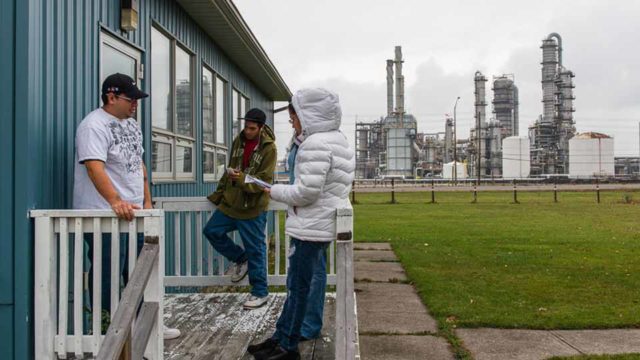For more than a decade, Ecojustice has worked with community members from Sarnia and the Aamjiwnaang First Nation (AFN) to safeguard their right to a healthy and ecologically-balanced environment. At the request of the AFN, Ecojustice analyzed the cumulative air pollution in their community, which led to the publication of our 2007 report, Exposing Canada’s Chemical Valley. The report assessed the impact of industrial air pollution on human health, and brought to light the health effects of living in one of the most polluted places in Canada.
After that report’s publication, Ecojustice undertook litigation on behalf of members of the AFN, engaged in law reform efforts, and used the Ontario Environmental Bill of Rights numerous times, to address the environment injustices in Chemical Valley. Now, in 2019, Ecojustice has published a follow-up report, Return to Chemical Valley, which provides an update on air pollution emissions using 2016 National Pollutant Release Inventory (NPRI) data, and includes analysis of the air quality monitoring data.
Since 2007, our efforts have helped to address some key issues, such as the lack of publicly-available air-quality data which left local residents in the dark about what was in the air they had to breathe. Soon after Exposing Canada’s Chemical Valley raised this concern, an air monitoring station was established on the AFN reserve. Now, near real-time air quality data from the AFN station and other air monitoring stations in the Chemical Valley area is available online — giving the community some peace of mind.
On the legal side, the province of Ontario has started on a framework to address cumulative effects of pollution and created some new rules around flaring, although flaring is still far too common. The Ministry of Environment and Climate Change adopted a new standard in 2016 that forces industry to address leaks of the carcinogenic substance benzene and publically report levels at their property lines. In 2018, the Ministry updated 40 year old standard that will significantly lower the level of sulphur dioxide any industrial facility can legally release into the air.
After a decade of work, air pollution around AFN has decreased. But environmental injustice in Chemical Valley continues, and more needs to be done to fulfil the community’s right to a healthy environment.
In 2007, we lacked data on air quality monitoring. Now that the data exists, our 2019 report examines it in detail and shows that, despite the decrease in pollution, there are still serious issues with air quality. For example, the air quality monitors show that Sarnia has the highest benzene levels in Ontario: double the Ontario standard. Monitoring around the refinery’s property lines shows levels as much as 55 times above the air-quality standard. Benzene is associated with acute myeloid leukemia, and a new study suggests Sarnia is a hot spot for this type of cancer.
In 2007, Exposing Canada’s Chemical Valley revealed a serious problem with the cumulative effects of air pollution – and 12 years later, this is still a major concern which has yet to be addressed. The Ministry of Environment and Climate Change has no formal, comprehensive policy on cumulative effects, and continues to assess each facility that pollutes as if it is the only one existing in the area. The reality is that there are 23 facilities in Chemical Valley emitting more than 50 tonnes of air pollutant per year within 25 km of the AFN. The highest emits over 13,000 tonnes.
Sarnia-area facilities released about 45,357 tonnes of air pollution in 2016. To put these numbers in context, in 2016 all Ontario facilities that report to the NPRI emitted approximately 455,439 tonnes of pollution into the air – which means that emissions from Sarnia area alone account for approximately 10 per cent of the total emissions across the province.
In June 2019, Baskut Tuncak, the United Nations Special Rapporteur on Human Rights and Hazardous Substances, visited Sarnia and AFN as part of an official country visit to assess and monitor whether Canada manages its toxic substances ways that ensure human rights are protected. The statement he made at the end of his tour was not very positive. Tuncak identified a “pervasive trend of inaction” from government towards addressing the health threats faced by Indigenous people in Canada, and described Chemical Valley in particular as “deeply unsettling.” He called what the AFN faces an “environmental injustice [that] is an ongoing tragedy.”
By permitting high levels of air pollution in Chemical Valley – pollution levels higher than almost everywhere else in Canada – the Ontario government has actively contributed this environmental injustice. Clear, strong, legally-binding air quality standards and stronger regulation of industrial air pollution emissions are necessary to protect Ontarians’ right to a healthy environment.
Return to Chemical Valley is available for download on our Publications and Reports page under the blue Research Reports tab.








